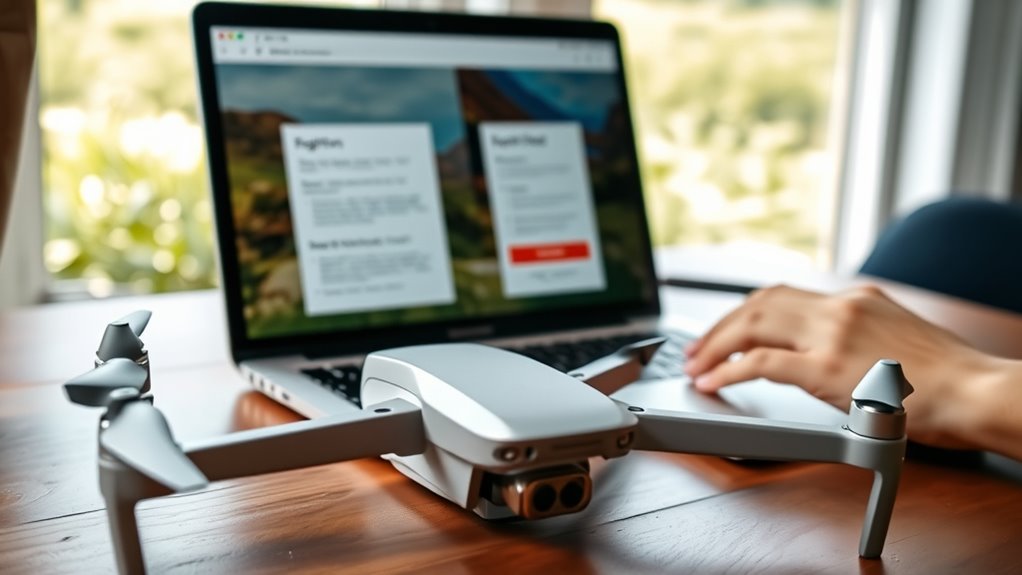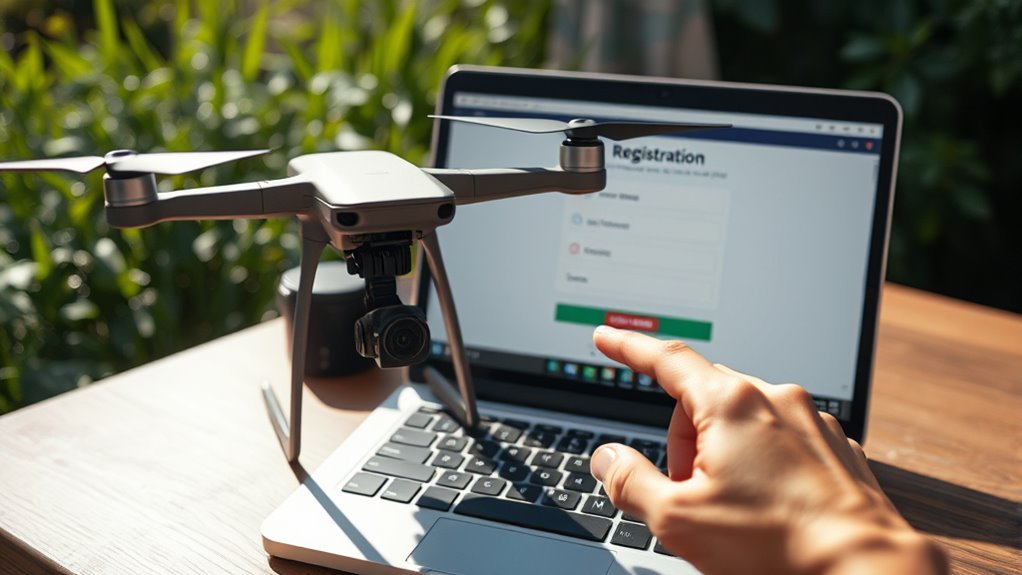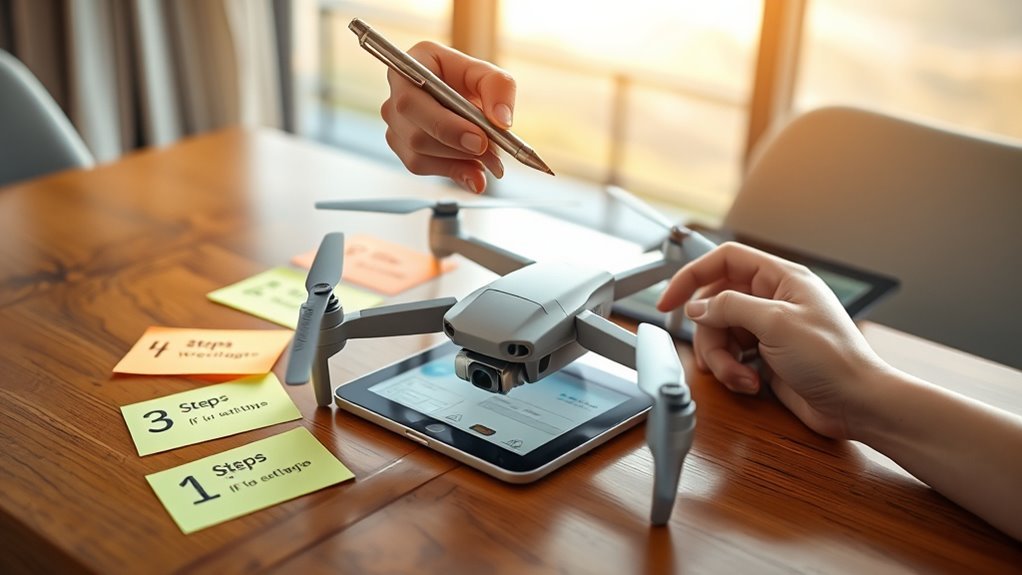To register your drone, start by understanding the registration requirements set by the FAA. Next, gather necessary information, including your name, contact details, and drone specifics. Choose either online or paper registration, then complete the relevant form accurately. Pay the registration fee, typically around $5, and guarantee you receive your registration certificate. Finally, mark your drone’s registration number clearly on its exterior. This process guarantees legal compliance and opens up more flying opportunities. There’s more to explore on best practices for registration.
Understand the Registration Requirements

Before you can fly your drone legally, it’s important to understand the registration requirements set by the Federal Aviation Administration (FAA). The registration process involves submitting your information online, including your name, address, and email, for drones weighing over 0.55 pounds. You’ll need to pay a small fee, and once registered, you’ll receive a unique identification number. This number must be displayed on your drone. Neglecting the registration process can lead to significant legal implications, including fines or restrictions on your flying activities. By complying with these requirements, you not only protect your freedom to operate your drone but also contribute to safer airspace for everyone. Understanding these regulations is vital for any responsible drone pilot.
Gather Necessary Information

To successfully register your drone, you’ll need to gather specific personal information, including your name, address, and contact details. Additionally, you’ll have to provide technical specifications of your drone, such as its make, model, and weight. Ensuring you have this information ready will streamline the registration process.
Required Personal Information
When registering your drone, it’s essential to gather specific personal information to confirm compliance with regulations. While you may have privacy concerns, providing accurate personal details is vital for a successful registration. Here’s what you’ll need:
- Full Name: This guarantees proper identification.
- Email Address: Used for communication regarding your registration.
- Physical Address: Required for official records and correspondence.
- Phone Number: To facilitate any necessary follow-up.
Collecting this information helps maintain accountability in the drone community while addressing privacy concerns. By being prepared, you can streamline the registration process and enjoy the freedom of flying your drone responsibly. Remember, accurate details not only fulfill legal requirements but also enhance safety in the airspace.
Drone Specifications Needed
While gathering personal information is crucial for drone registration, you also need to provide specific details about your drone itself. Start by identifying your drone type—whether it’s a quadcopter, fixed-wing, or another variation—as this impacts your registration process. Next, note the weight class of your drone; this can greatly influence regulations and requirements. Drones typically fall into categories like under 0.55 pounds, between 0.55 and 55 pounds, and over 55 pounds. Accurately recording these specifications not only guarantees compliance but also empowers you to operate your drone freely. Finally, include your drone’s manufacturer, model number, and any unique identification features. Having this information ready will streamline your registration and enhance your flying experience.
Choose the Right Registration Method

When it comes to registering your drone, you’ll need to choose between online and paper registration methods. Each option has its own advantages, so consider which one aligns best with your needs. Additionally, be sure to check local regulations, as they may impact your registration process.
Online Registration Process
Registering your drone online is a straightforward process that can save you time and effort. By choosing online registration, you’ll enjoy several benefits, including convenience and speed. To guarantee a smooth registration process, follow these key steps:
- Visit the official registration website: Make sure you’re on the correct site to avoid scams.
- Gather necessary information: Have your drone’s details and personal info ready.
- Complete the registration form: Fill in all required fields accurately to avoid common registration mistakes.
- Pay the registration fee: Use a secure payment method to finalize your registration.
Paper Registration Options
For those who prefer traditional methods, paper registration options are available for drone owners. You’ll need to obtain the necessary paper forms from your local registration office or download them from the official website. Fill out the required information accurately, including your contact details and drone specifications. Once completed, mail the forms to the designated registration office. This process may take longer than online registration, but it offers a physical record of your submission. Keep a copy of the forms for your records. Remember, ensuring compliance with federal regulations is vital for enjoying your drone’s freedom. By choosing paper registration, you maintain a tangible connection to your drone ownership and responsibility.
Consider Local Regulations
Although many drone owners opt for federal registration, it’s crucial to evaluate local regulations that may impose additional requirements. Ignoring these local laws can lead to fines or restrictions that could limit your flying freedom. To guarantee compliance, consider the following:
- Check local ordinances that may restrict drone use in specific areas.
- Review safety guidelines established by your city or state, as they could differ from federal rules.
- Investigate any required permits for commercial drone operations in your locality.
- Stay updated on changes to local laws, as they can evolve rapidly.
Complete the Registration Form
Completing the registration form is a crucial step in guaranteeing your drone is legally recognized. Make certain you have all necessary information ready, including your name, address, and drone details. Here are some registration form tips: double-check that your information is accurate and matches your identification documents. Common mistakes include misspellings and incorrect drone specifications, which can delay your registration process. Take your time and review each section carefully. If you’re unsure about any part, consult the guidelines provided by the regulatory body. By being thorough and cautious, you’ll avoid potential issues and guarantee your drone is registered properly, granting you the freedom to fly without worry.
Pay the Required Fees
After filling out the registration form, the next step is to pay the required fees for your drone registration. Understanding the registration fees and available payment methods guarantees a smooth process. Here’s what you need to know:
After completing the registration form, the next important step is to pay the necessary fees for your drone registration.
- Registration Fees: The standard fee for registering your drone is typically $5, covering your registration for three years.
- Payment Methods: You can usually pay via credit card, debit card, or electronic transfer.
- Confirmation: Verify you receive confirmation of your payment, as this will be essential for future reference.
- Budgeting: Factor in the registration fees when planning your drone budget to avoid any surprises.
Once you’ve completed this step, you’ll be one step closer to flying your drone legally and freely!
Receive Your Registration Certificate
Once you’ve successfully paid the registration fees, you can expect to receive your registration certificate, which serves as proof of your drone’s legal registration. This certificate isn’t just a formality; it grants access to various registration benefits, including eligibility for certain airspace and reduced penalties in case of violations. Additionally, being aware of federal laws protecting aircraft can help you understand the importance of maintaining compliance with regulations. Furthermore, understanding the no-fly zones in your area will ensure that you operate your drone safely and legally.
| Aspect | Details | Importance |
|---|---|---|
| Legal Compliance | Guarantees your drone’s operation is within the law. | Avoids fines and legal issues. |
| Flight Permissions | Facilitates access to restricted airspaces. | Expands your flying capabilities. |
| Proof of Ownership | Validates your rights as a drone owner. | Essential for insurance claims. |
Mark Your Drone With the Registration Number
To comply with registration requirements, it is essential to mark your drone with its unique registration number. This guarantees registration visibility and helps authorities identify your drone if needed. Here’s how to properly execute drone marking:
Mark your drone with its unique registration number to ensure visibility and assist authorities in identification.
- Choose a Permanent Method: Use a durable label or engraving method to guarantee the number remains visible.
- Select an Appropriate Location: Place the registration number on the exterior of the drone, ideally on the underside, to protect it from damage.
- Use Legible Characters: Make sure the registration number is easy to read, using clear, bold characters.
- Maintain Visibility: Regularly check to guarantee the number hasn’t faded or become obstructed.
Following these steps will guarantee you meet the requirements and can enjoy flying your drone freely.
Frequently Asked Questions
Can I Register Multiple Drones Under One Registration Number?
You can’t register multiple drones under one registration number. Each drone requires its own registration due to FAA regulations. Proper registration maximizes your drone ownership benefits and guarantees compliance with the law, enhancing your flying freedom.
What Happens if I Lose My Registration Certificate?
If you lose your registration certificate, don’t panic. You’ve got replacement options. However, losing that certificate could mean complications with law enforcement or fines. Always keep a backup—freedom requires responsibility, after all.
Is There an Age Limit for Drone Registration?
There’re no specific age restrictions for drone registration, but you’re typically required to be at least 13 years old to register. If you’re under 18, a parent or guardian must sign the application.
Can I Register My Drone Online?
Like a knight entering a digital domain, you can register your drone online. The drone registration process simplifies your journey, and online application benefits include speed, convenience, and instant access to important regulations. So, get started!
How Long Does the Registration Process Take?
The registration timeline typically takes a few minutes, but processing delays can occur depending on demand. To guarantee a smooth experience, it’s wise to register during off-peak hours for quicker confirmation of your drone’s registration.

